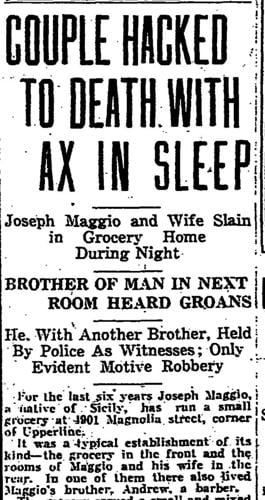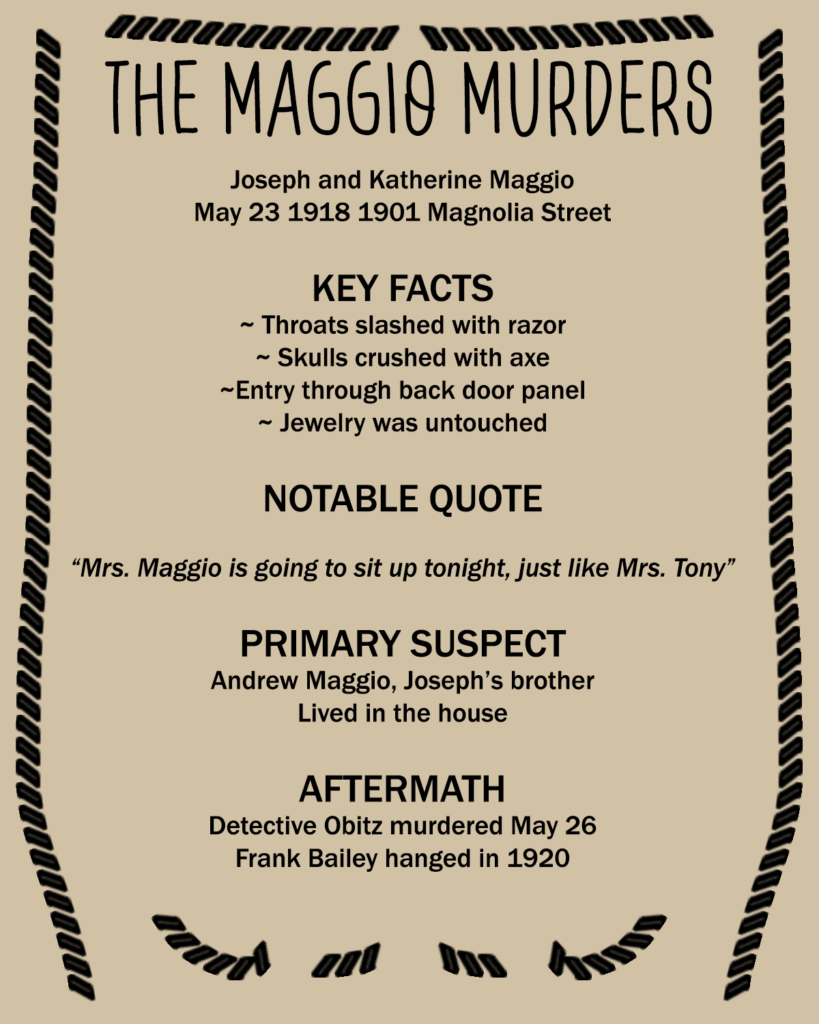Your cart is currently empty!
The Maggio Murders and the Strange Case of Detective Obitz




Got it! Here’s the cleaned-up wiki page with no dashes, em dashes, or dash-like punctuation:
The Maggio Murders and the Strange Case of Detective Obitz
First Blood: May 23, 1918
Location: 1901 Magnolia Street, New Orleans, Louisiana
Victims: Joseph and Katherine Maggio
Status: Deceased
Relation to Axeman Case: First widely acknowledged victims of the Axeman of New Orleans
Overview
Joseph and Katherine Maggio were a married couple living and working at the corner of Magnolia and Upperline Streets in New Orleans, where they operated a grocery store and saloon. In the early hours of May 23, 1918, they were brutally attacked in their bedroom. This event would come to be recognized as the beginning of the reign of terror carried out by the Axeman of New Orleans.
The Maggio case was defined by grotesque brutality, a puzzling crime scene, and the suspicious arrest of a grieving family member. It was further complicated by the sudden death of a detective on the case just days later.
The Scene
At approximately 4:45 a.m., Joseph’s younger brother, Andrew Maggio, who lived in an adjoining room, was awakened by groaning sounds through the wall. Instead of immediately investigating, he fled the house and roused his brothers, Jacob and Salvadore. The three returned around 5:15 a.m.
What they found was a horrifying scene:
Joseph Maggio lay diagonally on the bed with his feet touching the floor. He was still alive but mortally wounded.
Katherine Maggio was already dead, her body on the floor at the foot of the bed. Her throat had been slashed nearly to decapitation.
Both victims had their skulls crushed, likely postmortem, using an axe.
Blood soaked the bed, pooled on the floor, and splashed up the walls over seven feet high.
Crime Scene Clues
The killer appeared to have entered quietly and moved with disturbing calm:
A panel had been removed from the back door using a screwdriver.
The couple’s own axe was taken from the backyard and used in the attack.
A bloody straight razor was recovered and later traced to Andrew Maggio’s barber shop.
A blood-soaked suit and socks were found in a nearby yard.
A chalk message was discovered on a sidewalk a block away:
“Mrs. Maggio is going to sit up tonight, just like Mrs. Tony”
The home had not been ransacked. A small metal box containing under fifty dollars was smashed, but jewelry and other cash were left untouched. A safe had been opened but showed no signs of forced entry.
Suspicions: Andrew Maggio
Andrew Maggio quickly became the focus of the investigation. Suspicious elements included:
The razor linked to his barber shop.
A stained shirt in his possession.
His delay in responding to the sounds of the attack.
His own admission that he had been heavily intoxicated the night before.
The press labeled him the prime suspect, and he was held for intense questioning. Under pressure, he broke down, describing Joseph as a father figure and expressing anguish over the murders. When the forensic evidence began to unravel, Andrew was released on May 25, two days after the killings.
The Strange Aftermath: Death of Detective Obitz
The case took an even darker turn just hours after Andrew’s release. On May 26 around 3:00 a.m., Detective Theodore Obitz, one of the lead investigators, was shot and killed while sitting on a stoop during a robbery investigation. A confrontation with a suspect ended in a deadly shootout.
In the chaos that followed, police gunned down two innocent Black men, Louis Johnson and Abraham Price, during the manhunt. No officers were held accountable for their deaths.
Eventually, seventeen-year-old Frank Bailey was arrested. He confessed to several robberies and to Obitz’s shooting, but later recanted. Bailey claimed that Obitz was accidentally shot by his fellow officer, Harry Dodson. The jury did not believe him. Bailey was convicted and hanged on August 13, 1920.
In a final interview, Bailey condemned the police and refused clemency:
“When I have been executed, nothing will have been taken out of this world Friday. If there is such a thing as a spirit coming back to earth, I do not want to come back.”
Legacy
The Maggio murders introduced the world to many of the hallmarks of the Axeman’s pattern:
Forced entry through the back door
Use of the victims’ own household tools as weapons
Targeting of Italian grocers
Brutal, blood-soaked crime scenes
No clear motive
No one was ever charged in the deaths of Joseph and Katherine Maggio. The horrifying details and bizarre aftermath launched one of the most infamous unsolved serial murder cases in American history.
Sources Cited
Axeman of New Orleans Wikipedia
The Axeman of New Orleans Preyed on Italian Immigrants
Fear The Axeman of New Orleans
‘A peculiar turn’ in the Axeman investigation of 1918
Louisiana True Crime: The New Orleans axeman who murdered Italian grocers unfond of jazz
Leave a Reply